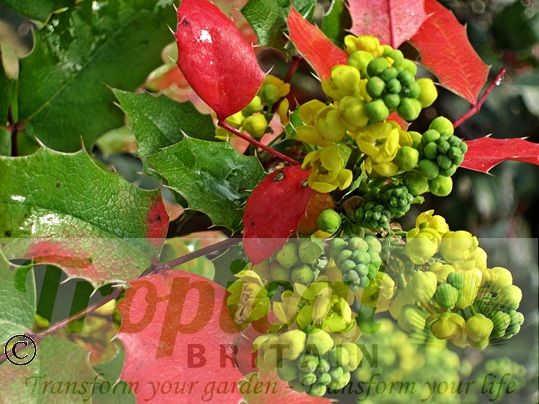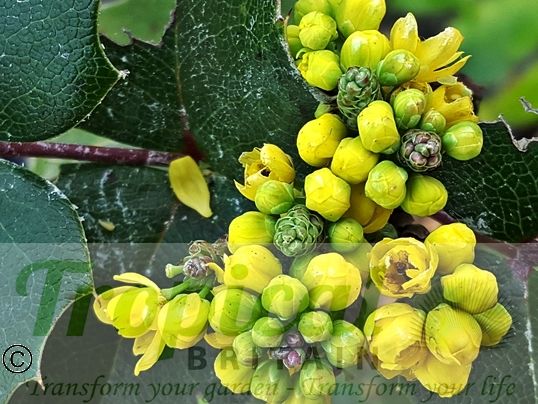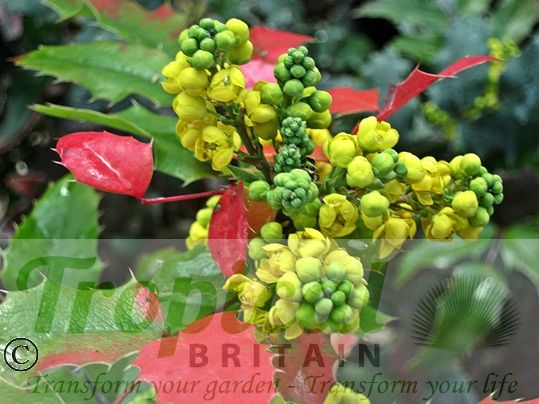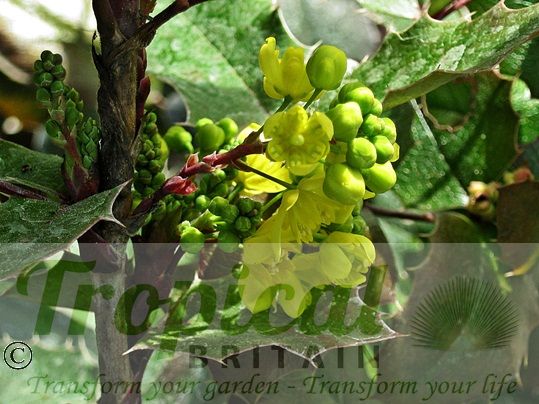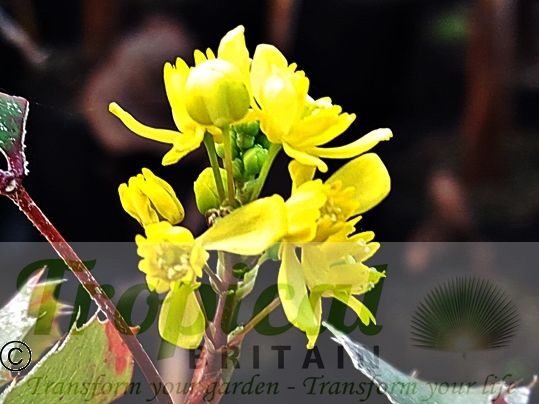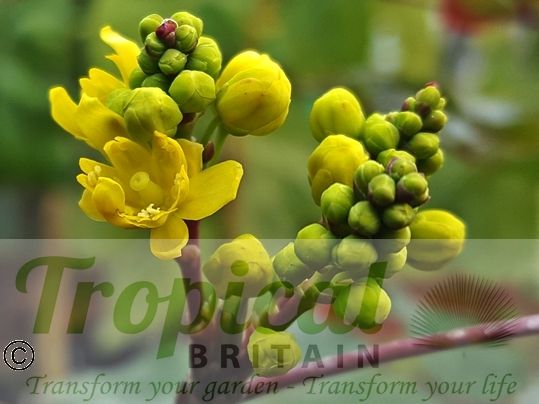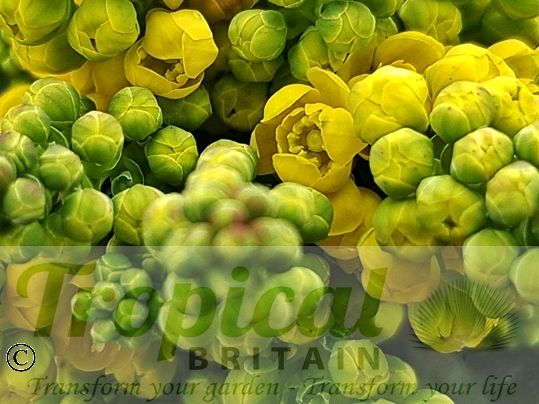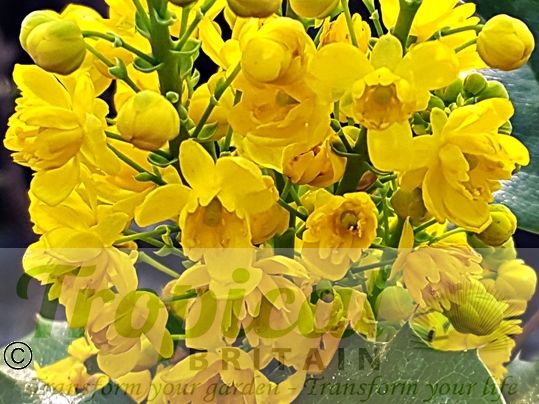Mahonia aquifolium
Mahonia aquifolium, the Oregon-grape, is an evergreen shrub, native to the western states of North America from British Columbia to northern California and stretching inland from the Pacific coast to Montana and Idaho, occuring in woods, brushlands and oak and conifer forests and on slopes up to an altitude of 2,100 m. A tough and very hardy shrub, the Oregon Grape has glossy dark-green holly-like foliage arranged in an attractive pinnate structure and it is this pinnate foliage, perhaps more than anything, that gives Mahonia aquifolium its distinctive ornamental quality. All too often used in the past in uninteresting low-maintenance mass-plantings by uninspired and creatively-challenged landscapers, Mahonia aquifolium deserves a better opportunity to showcase its qualities. Let's look again at this under-appreciated plant. It is a hardy drought-resistant evergreen; it has exotic-looking pinnate foliage that colours to a deep burgundy-red; it has attractive racemes of delicate and fragrant, bee-friendly yellow flowers; it has interesting panicles of purple-black berries that can be made into jam and also have medicinal properties. Beyond these not inconsiderable points in its favour and most importantly in my opinion, it makes an excellent exotic specimen when used in creative combinations with plants that have differing and contrasting foliage shapes.
Bernard M'Mahon, after whom the genus was named, is an extremely interesting figure in the annals of horticulture. Born in Ireland in 1775, he emigrated to America in 1796 in what was a formative time in American history. In 1802 M'Mahon published the very first seed list in America, the 'Catalogue of Garden Grass, Herb, Flower, Tree & Shrub-Seeds, Flower Roots, &c' and in 1804 he published another catalogue devoted entirely to American native species. In 1806, he published the first nurseryman's guide to planting, 'The American Gardener's Calendar: Adapted to the Climates and Seasons of the United States', which saw 11 editions and was printed long after his death until 1857. It was a comprehensive survey of the gardening year and was the most respected American horticultural guide of its day and included - amongst much else - the hothouse cultivation of tender exotics like pineapples, begonias, hibiscus, lantana and plumeria; the cultivation of indigenous American wildflowers and the first published information in America about landscape design, an eighteen page essay entitled "Ornamental Designs and Plantings" that advocated an informal style of naturalistic gardening in the manner of Humphry Repton. Through this Calendar, M'Mahon become one of Thomas Jefferson's advisors and frequent correspondent and supplied Jefferson with plants for his garden at Monticello. Jefferson regarded M'Mahon's Calendar as his horticultural Bible. Upon the return of the Jefferson instigated expedition by Lewis and Clark to the Pacific Coast, M'Mahon, under Jefferson's instructions, became one of the custodians of the seeds gathered by Lewis and Clark and they were given to him for cultivation and ultimate distribution. M'Mahon was also instrumental in getting the brilliant but troubled Frederick Pursh to work on the drawings and descriptions of the catalogue of the expedition's botanical collection. Pursh had originally designated the plant as Lewisia ilicifolia and then later, Berberis aquifolium. In 1818, two years after M'Mahon's death, Thomas Nuttall, who had been a frequent guest at M'Mahon's nursery, honoured him in his 'Genera of North American Plants' by naming specimens collected by Lewis and Clark, "in memory of the late Mr Bernard M'Mahon, whose ardent attachment to Botany, and successful introduction of useful and ornamental Horticulture into the United States, lay claim to public esteem." Seven years later, in 1825, when it was already well know on the Eastern seaboard, Mahonia aquifolium was so valued as an ornamental species that the Prince Nursery in Flushing, Long Island, was offering specimens in their catalogue for an extraordinary $25, an unimaginably large price in today's money.
I am happy to offer these plants at a fraction of that price. My advice is to grow them tall. Prune the side shoots and create narrow upright specimens, allowing them to reach a full specimen height where they will develop their true exotic potential and their magnificent pinnate foliage can be seen in sculptural silhouette against the sky. Grow them in imaginative combinations with contrasting foliage types and do you bit to restore a highly ornamental plant to its rightful position as as an esteemed botanical genus, an exotic with a truly historic heritage, first collected by an exhausted Captain Meriwether Lewis on the banks of the Columbia River on 11 April 1806. Two months previously, on 12 February 1806, Lewis wrote in his journal the first ever record of Oregon Grape, “...two species of evergreen shrubs I first met with at the grand rapids of the Columbia... I do not know the fruit or flower of either, the 1st resembles the plant common to many parts of the U’States called the mountain holley”
Additional Information
| Order | Ranunculales |
|---|---|
| Family | Berberidaceae |
| Synonyms | Berberis aquifolium, Berberis aquifolium var. aquifolium, Berberis piperiana, Lewisia ilicifolia, Mahonia piperiana, Odostemon aquifolium |
| Geographical Origin | Canada and USA : British Columbia, Washington, Oregon, Northern California, following the line of the Cascade Range and inland to Montana and Idaho |
| Cultivation | Prefers partial or dappled shade but tolerates full sun; its foliage turns redder in the sun and sometimes speckling occurs on the foliage if there is too much sun. Any well-drained soil |
| Eventual Height | 3 m |
| Eventual Spread | 1-2 m |
| Hardiness | Fully hardy |

Free DELIVERY
ON ALL ORDERS OVER £99THIS OFFER IS VALID ON ALL OUR STORE ITEMS.

